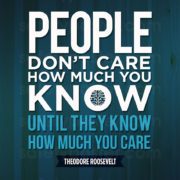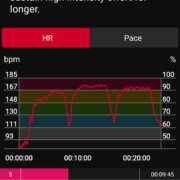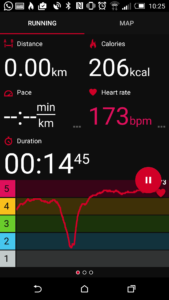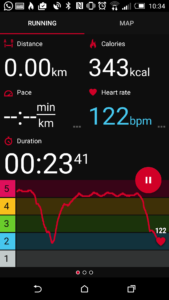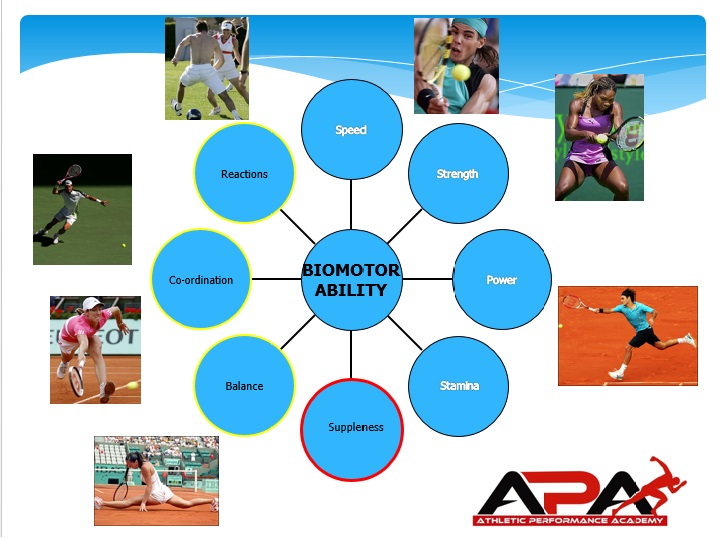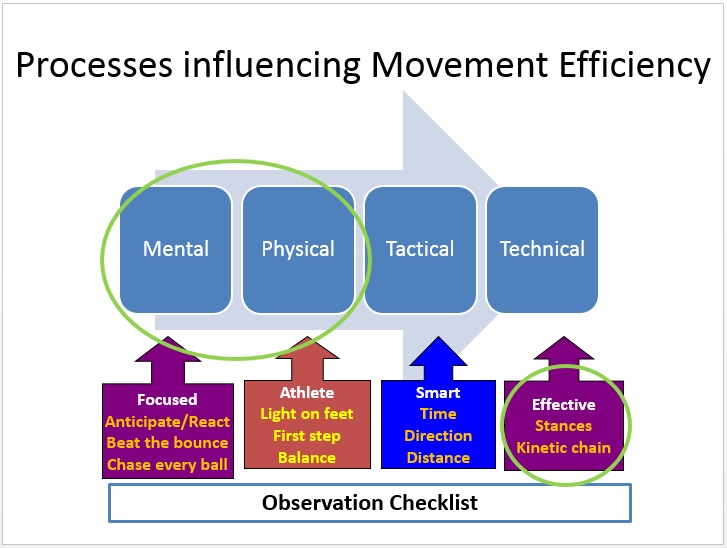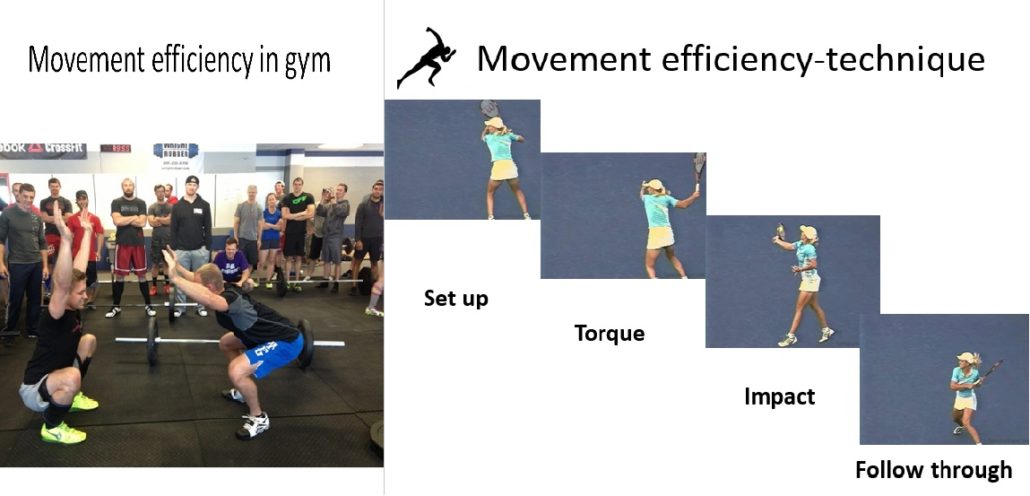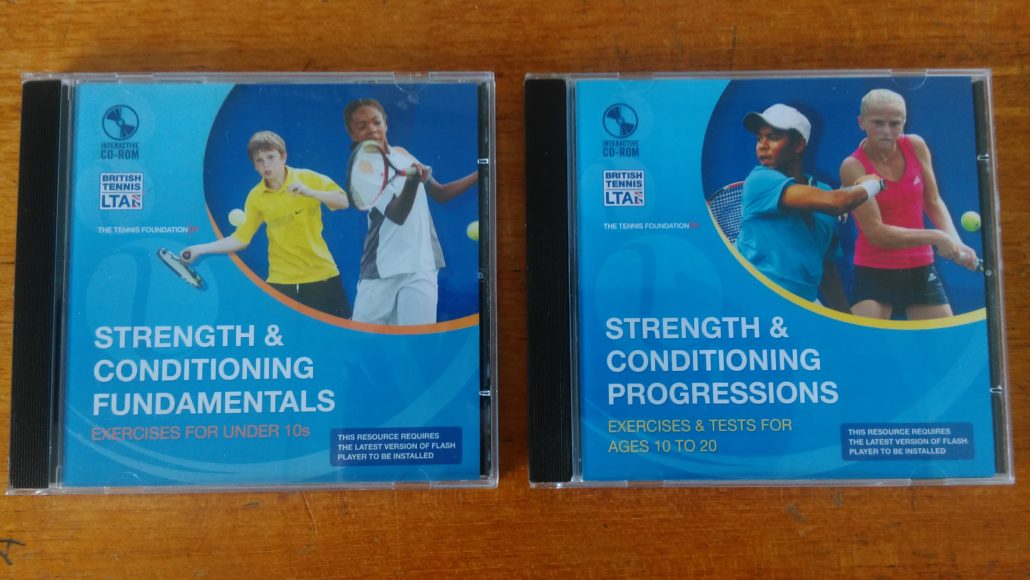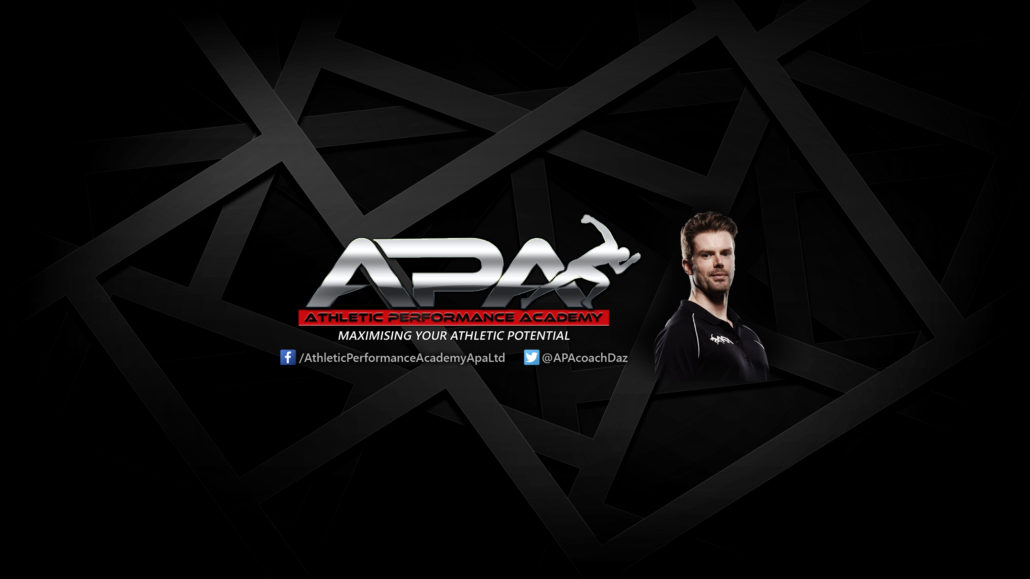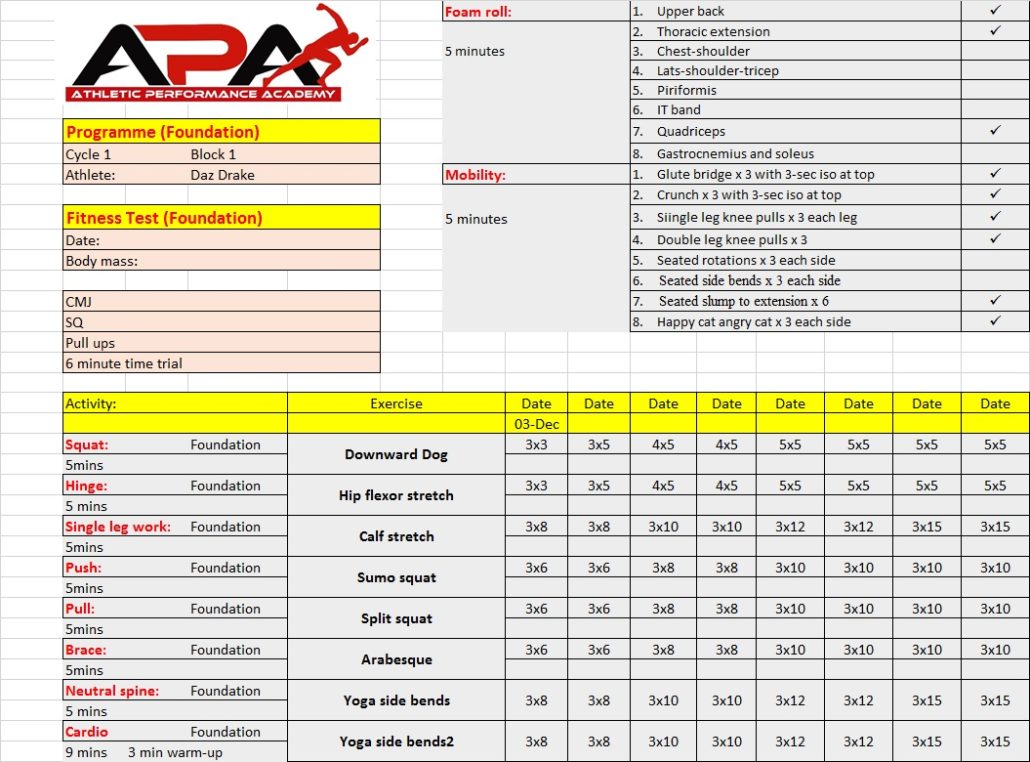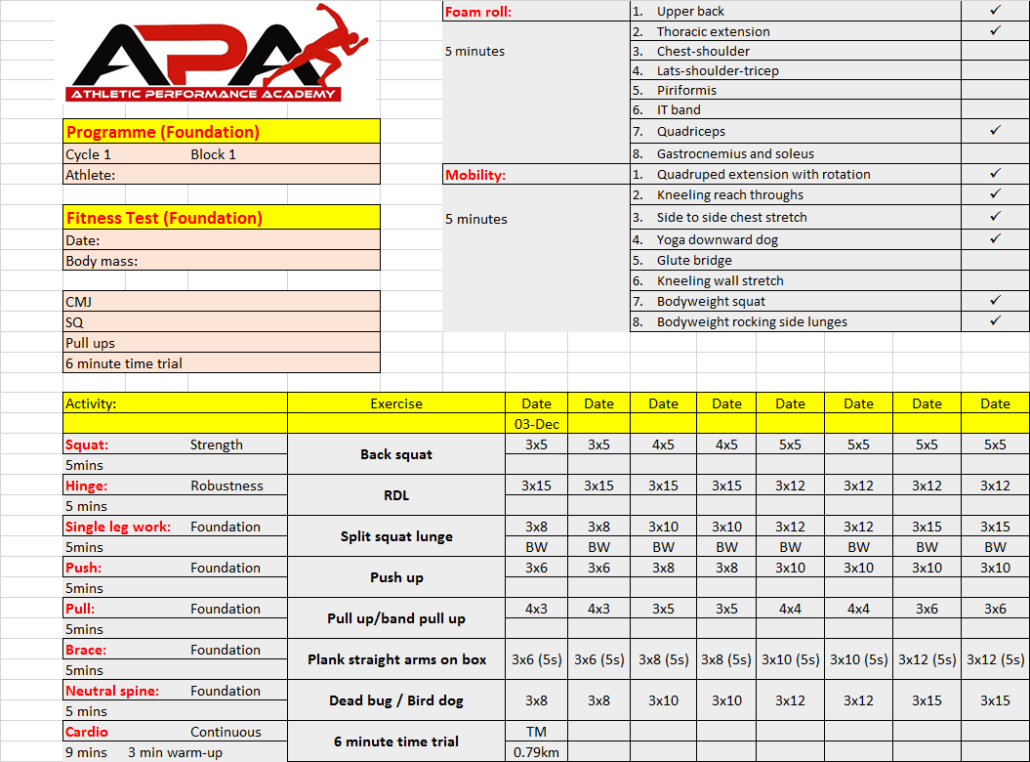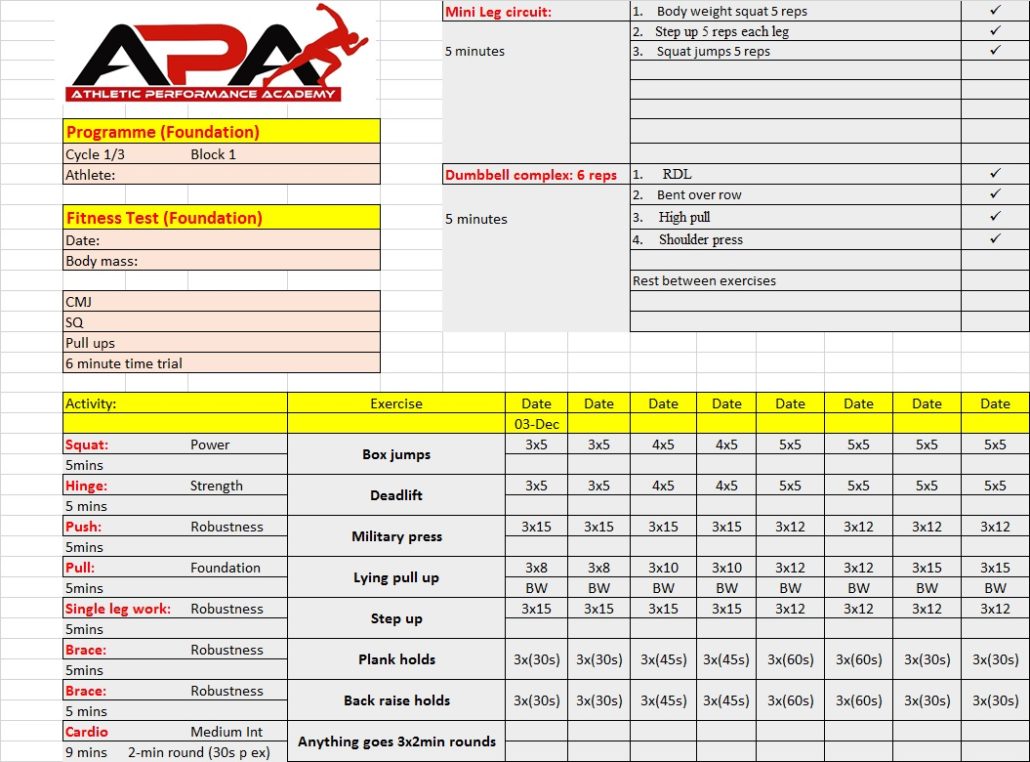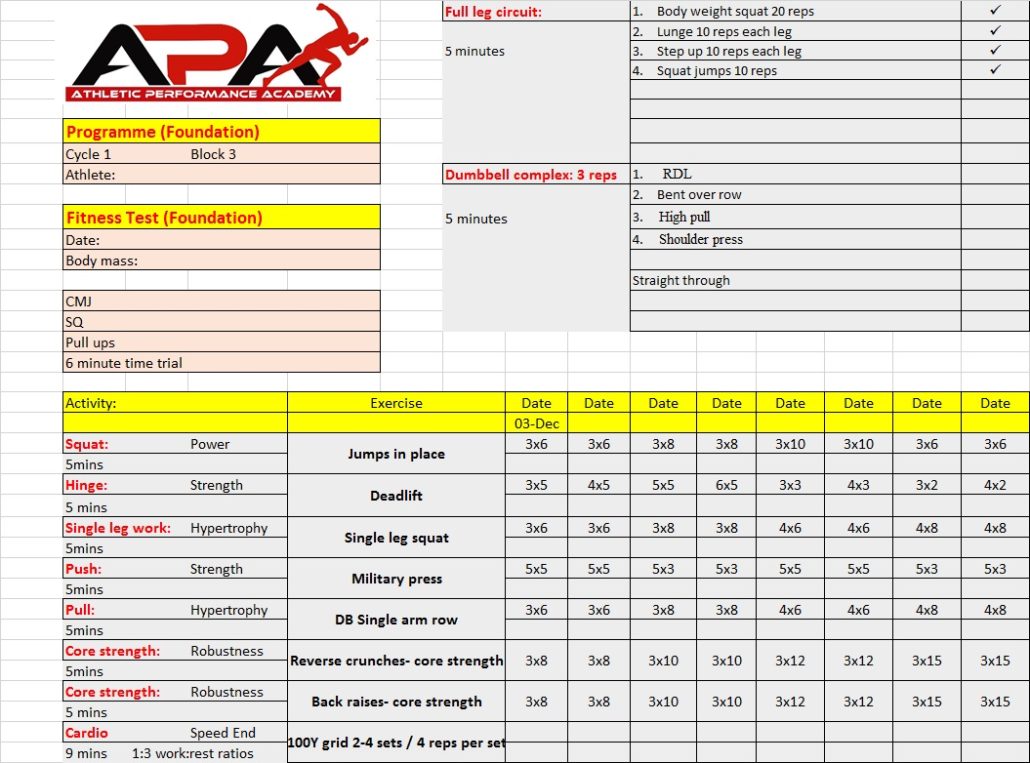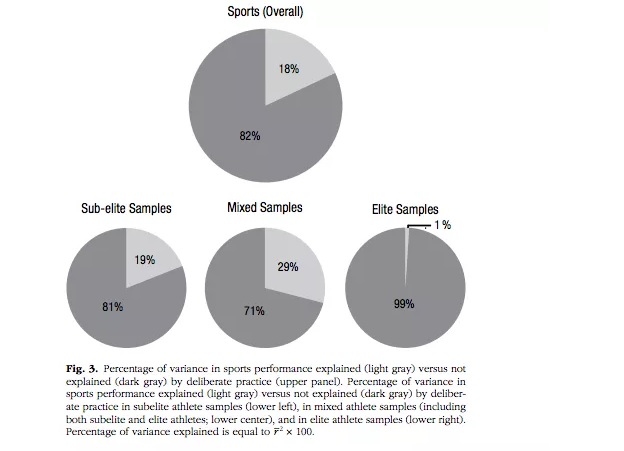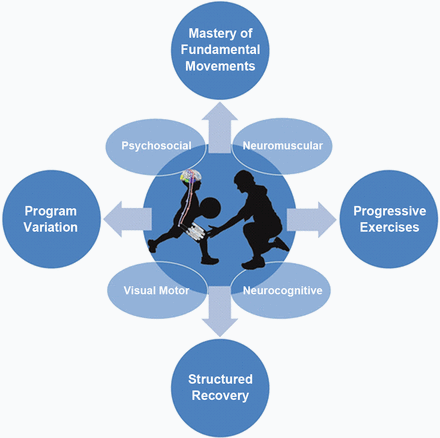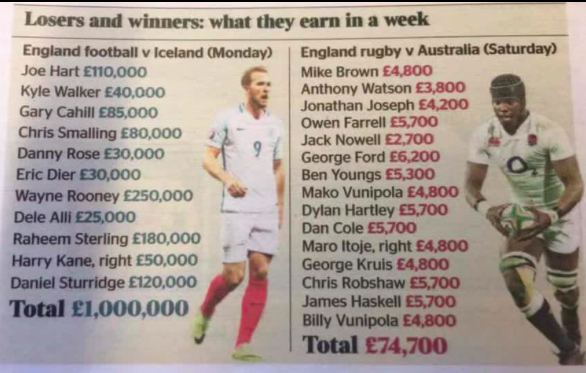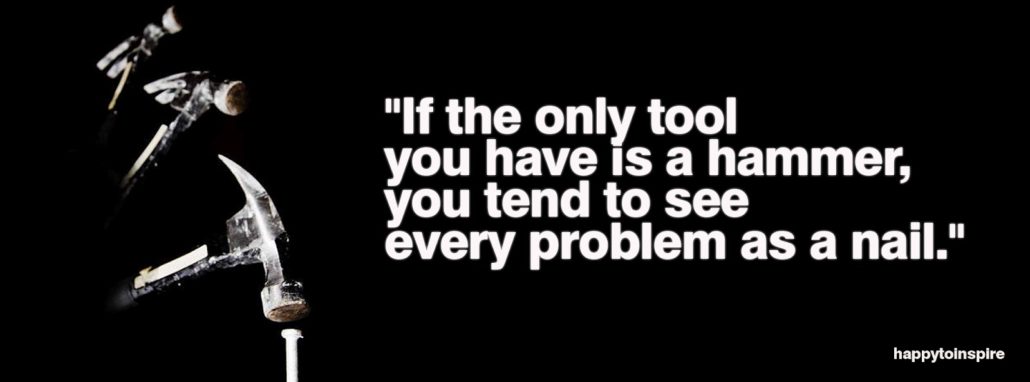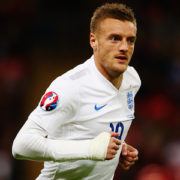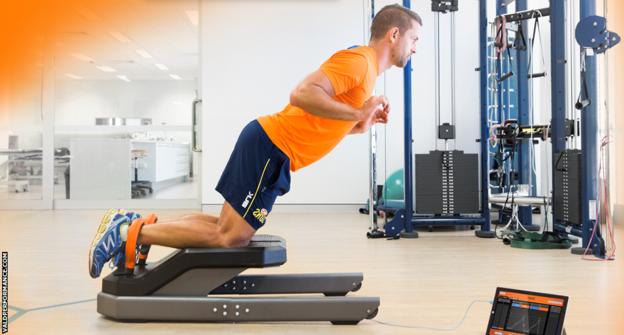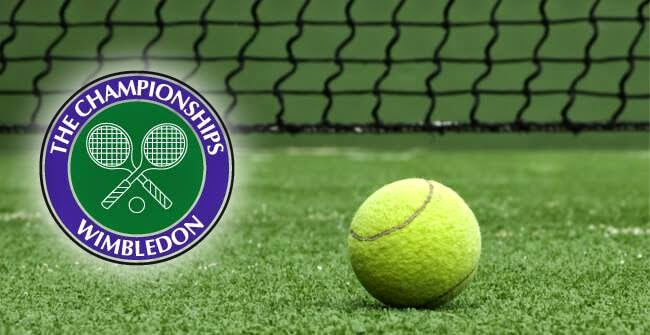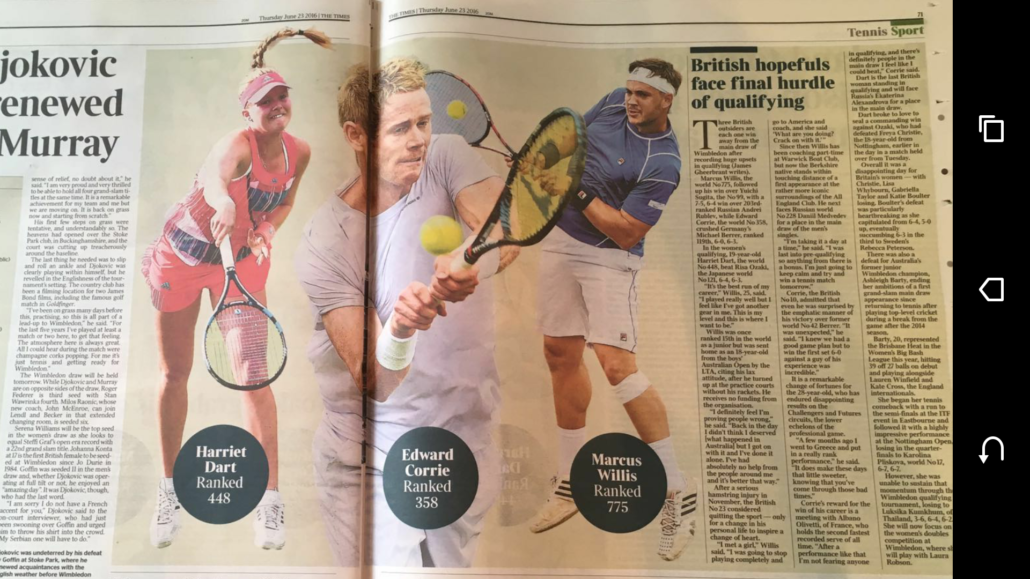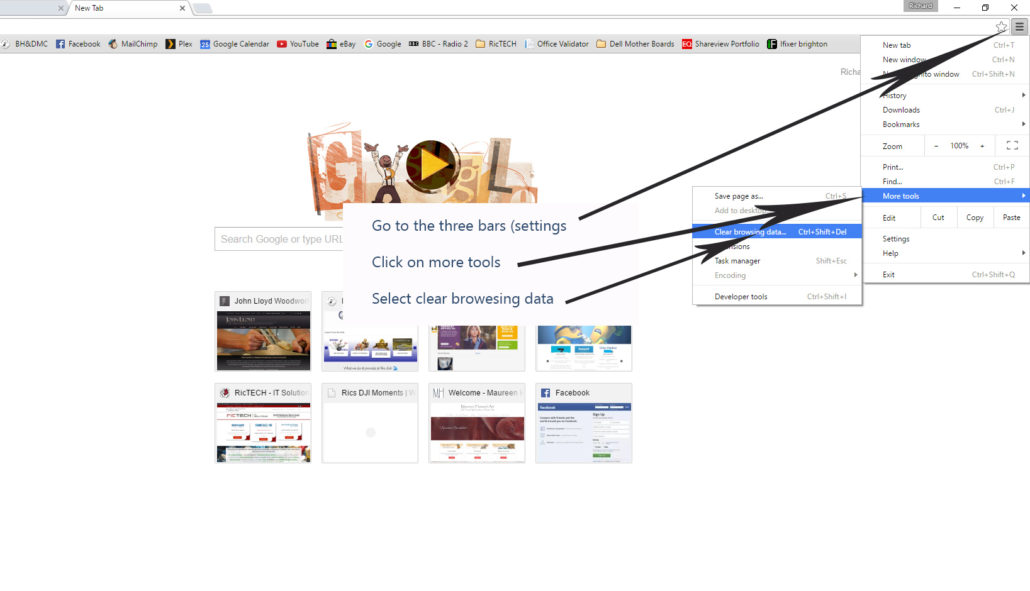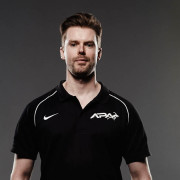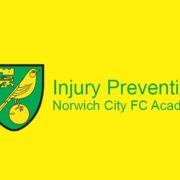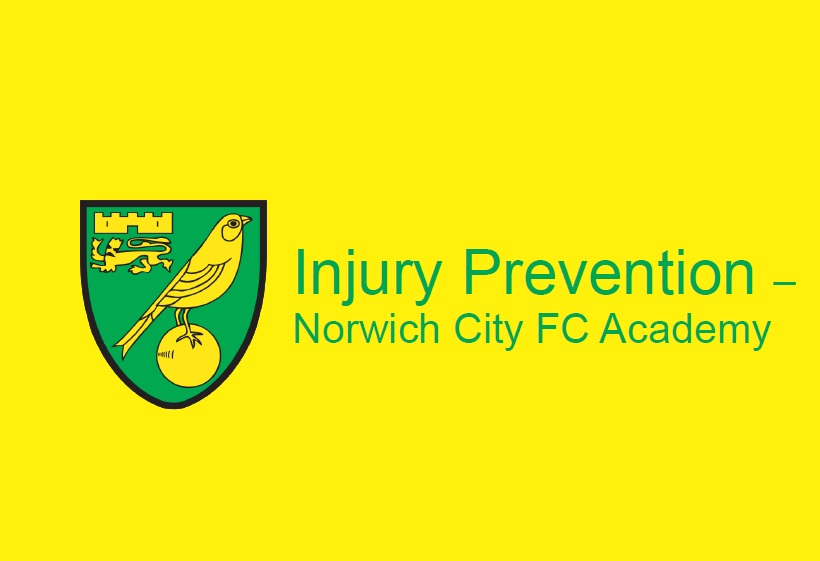Athletic Performance Academy – Latest news & updates from Athletic Performance Academy
Footwork Fitness
/in APA Blog /by dazdrakeIn this week’s blog I would like to give an example of how we can develop the role of S&C in sport skills coaching at the elite level. Last week I wrote about some of the ways we can assess/train physical qualities within a sports coaching session (click HERE). This should hopefully empower sports coaches to work on the fundamentals even if they don’t have the resources to pay for a full-time S&C coach.
Footwork Fitness
In this instance I want to talk about a session where a sports coach could conceivably be working on development of a physical quality (endurance) while at the same time working on a tennis player’s sports skills (footwork).
This week I had the privilege to work with a professional Tennis player who as part of their physical programme was incorporating some endurance into their training week. Given that the workload of a professional player’s session is often at the high end of intensity and mechanical loading it is often smart to think of ways to either:
a) incorporate cardiovascular endurance into tennis sessions
b) perform additional cardio sessions that minimise excessive joint loading
Some times you actually want to do more mechanical loading such as a running based session but with all the pounding the body takes from moving on the court for 2-4 hours per day, in this case we went for an option that put less impact loads on the body by working on footwork rather than sprinting or high intensity running.
Use of a mask
For this session the athlete is wearing a training mask 2.0. Find out more about it HERE

Here’s an overview of what the developers have to say
Respiratory training is a new concept in the fitness arena and the Training Mask 2.0. is a light, hands free, functional respiratory resistance trainer that strengthens the muscles you use to breathe. The diaphragm is the centerpiece of your breathing musculature. Training Mask 2.0 kills two birds with one stone by strengthening your breathing muscles and creating a hypoxic environment for you train in. No mountains required.
I have seen social media light up with haters ready to criticise use of any such training device. But just to be clear I use it for one simple reason- it makes the athlete feel like the session is harder. I’m not going to enter into a debate as to whether it creates hypoxic conditions or it doesn’t, whether it increases VO2max or it doesn’t or whether it strengthens the breathing muscles or it doesn’t; I’m simply finding a way to jack the heart rate up without needing to increase the mechanical loading associated with high speed running and/or change of direction. It does!
Feedback from the athlete is that the same footwork drills done wearing the mask make him feel like he is working much harder. I’m actually going to ask the athlete to repeat the same sessions in a few days without the mask so I’ll put the heart rate data up for comparison. But I can tell you in advance, what you will see is that the heart rate will be higher for the same level of footwork intensity wearing a mask, and that’s all that we care about.
Work to rest Ratios
I have posted the video below and the screen shots of the Heart rate data so you can see the cardiovascular response to a session which a Tennis coach can easily do with a tennis player that will help develop some sports skills (footwork) at the same time as working on endurance.
This five-minute video shows you a complete session plan that was used with a Professional Tennis player that works on cardiovascular endurance whilst performing tennis specific footwork patterns.
By keeping the work to rest ratio 2:1 and using work intervals between 20 and 40-seconds it keeps the heart rate elevated.
Session Plan
Summary
The average heart rate of the session was 152bpm and the Maximum Heart rate was 175bpm for a male Professional player. This is actually very similar to the Heart rate profile of a competitive match- although the actual work profile of the entire match will look slightly different to the heart rate summary profile above.
First step speed 6 minute block
Figure 8 lateral 20 seconds work: 10 seconds rest x 2
Figure 8 forwards 40 seconds work: 20 seconds rest x 1
Figure 8 backwards 40 seconds work: 20 seconds rest x 1
Repeat again, then have 90-seconds rest
Tennis footwork: lateral baseline movement 6 minute block
All exercises 30 seconds work: 15 seconds rest
Forehand only
Backhand only
Forehand and Backhand
Forehand and Inside Out Forehand
Repeat again, then have 90-seconds rest
First step speed Diagonals 6 minute block
All exercises 40 seconds work:20 seconds rest
Short Backhand: Deep Forehand
Short Forehand: Deep Backhand
Short Forehand and Backhand: Deep Forehand and Deep Backhand
Repeat again, then have 90-seconds rest
Total time: 24 minutes
Heart Rate Recovery
The goal is to get the Heart Rate down to 120 beats per minute after every 90-second rest period which the athlete successfully did indicating a high level of conditioning.
Hope this helps and I look forward to hearing how you get on applying these drills into your own training.
The Role of S&C in Sports Skill Development
/in APA Blog /by dazdrakeThis week I had the privilege to be invited to speak at a Lawn Tennis Association Level 4 Coaching Qualification. This qualification was being run by Nigel Long, a director of UCoach and I was asked to speak to the tennis coaches as part of the physical development section of the course.
The brief was to discuss optimal physical training programmes for junior performance tennis players from 5-16 years, highlighting the typical methods, frequency of sessions and so on that might be expected to be carried out. It is never easy to condense so much into one day but I did my best and feedback was that it was well received. Here is what we covered:
In the morning I delivered a presentation entitled: ”The role of S&C in stroke development.” We looked at three ke y themes:
- Long term Athlete Development (LTAD)
- Technical Checklist
- Coaching Footwork
There were some break out practicals to keep them alert and engaged as part of this presentation as well as some video analysis of footwork.
In the afternoon we looked at the Annual Plans that I have prepared for the various performance squads discussing expected training to competition ratios and the emphasis I place on different physical components at certain times of the year. We also did a warm-up practical.
Below are some summary points from the morning’s presentation:
Long term Athlete Development (LTAD)
I think it is vital to put into context the role of physical preparedness at different stages of the tennis journey. Clearly the number of years you have been playing has the biggest contribution to tennis performance (resulting in winning) in the game at 11 and under. It is not so important how fast or coordinated you are in a general sense- what counts is who has been playing tennis the longest.
As you progress through the ranks it is evident that the role of the physical attributes of the tennis player become ever increasingly important- where upon at the pro game we can conclude that physical attributes such as speed, power and coordination are vital to tennis performance.
Well duh? That’s obvious right?
Well, while it may not come as a surprise, what surprises me though is the reluctance to give physical development enough priority in training during the years of training as a child and adolescent. If we can all agree that it is of vital importance then why can’t we agree it needs more training time as the child grows up? Do we perhaps assume that growth and maturation takes care of its development? I’m not sure but what I like to stress with coaches is that growth and maturation isn’t enough- time and time again research has shown that training related improvements in physical qualities can far exceed those developed through growth and maturation alone.
We talked about the priority areas for physical development– which if you have ever attended an APA Training course you will be familiar with the 5 S’s (Suppleness, Skill, Strength, Speed, Stamina).
We also talked about how many hours of Tennis and S&C per week. As far as hours go we can get into all kinds of discussions about how many hours to do per week, per year etc and of course we absolutely have to factor in talent into this discussion.
Definition of Talent: the rate of learning

I wanted to offer this definition to get the coaches to view talent beyond the apparent genetic physical attributes but also the apparent rate with which they are able to acquire motor skills from a motor learning stand point. Once we grasp this concept we can view rate of learning like internet download speed- everyone will get there in the end but some people will take longer than others to download the information you are giving them.
Technical Checklist
For me this is a critical part of the cross-over between S&C and Sports Coach. Every Sports coach has a technical checklist- basically a technical model of correct technique from a bio-mechanical standpoint. We talked about KINEMATICS versus KINETICS.
As you will see in the slide above the technical checklist has a consideration of stances (footwork aka set up) and kinetic chain (bodywork/torque, impact and follow through). These would be considered the KINEMATIC aspects of technique- what the stroke should look like.
The message I wanted to get across to the tennis coaches is that perhaps the best question they can ask an S&C coach is: ”Are there any physical limitations in their performance that would prevent them being able to execute this tennis technique?”
Perhaps they lack the suppleness to get into the technically correct position- which effects their kinematics. But more often they also lack the required strength/speed to produce elements of the stroke due to their kinetics. They can’t produce enough FORCE or at the required speed to execute elements of the required technique.
Now I explained that the gold standard is to conduct fitness tests and assessments to determine the athlete’s level of preparedness and whether they have the required levels of strength, power and speed to meet the demands of the game. That’s where we come in. But if they don’t have these kind of resources they can still conduct their own on court assessments.
Look at things like:
- Being light on your feet- skipping
- Having an explosive first step- Figure 8 drill
- Arriving at the ball in balance- hop and stop test
There are many simple exercises to assess this and train it. This leads nicely into the last section
Footwork
As Louis Cayer once told me, if an S&C coach is going to teach/train footwork then they had better know what they are talking about. You certainly have heard of the quote:” A little knowledge is dangerous.” We don’t want to undermine our selves by going outside of our scope of practice.
Role of the Tennis coach:
In my experience the tennis coach is therefore in the best position to teach/train specific footwork patterns on the court in terms of how to move to hit a ball. But there are a number of physical qualities that need to be present which I discussed above.
The physical traits above of being light on your feet, having an explosive first step and arriving in balance could be worked on BY THE TENNIS COACH using some more general drills as part of the tennis lesson such as the ones below:
Skipping- Target 200 in 1-minute
Figure 8 drill- Target 4 in 10-seconds
Figure 8 forward- Target 5 in 20-seconds (if doing a jump at the completion of every figure 8)
Hop and stop- stick at 90 degree knee angle for 3 seconds at 50% of standing height
I personally believe these could be used by the tennis coach to get an indication of their athlete’s athletic profile in the absence of some of the fitness testing knowledge that an S&C coach will have.
Role of S&C coach
Primary goal: improve the kinetic capabilities of the athlete in the gym- ability to produce more force
If the S&C coach has further knowledge and skills that mean they can coach the specific footwork of the tennis stroke then further transfer of physical gains can be made, and this should be encouraged.
Further information for Tennis Coaches:
Finally, to get further information I highly suggest the LTA CD-Rom Resources
And also APA’s Level 2 Certificate in Strength & Conditioning. We will announce the dates for October/November 2016 shortly.
Get a Years Worth of Training Programmes FREE right HERE!
/in APA Blog /by dazdrakeYes that’s right- I’m giving a year’s worth of training away for FREE. I thought I would give my regular blog readers a treat and record some of the programmes to video we have been successfully using with our Adult Group Fitness training session on a Tuesday night.
Background on APA Training Philosophy
Want to have more success in sport?
At APA we believe that the best way to improve faster and win more is to get fit for your sport.
Our 12 weeks to Peak Training Programmes are designed to maximise your athletic potential and get you in peak physical condition. We get you fitter, faster and stronger so you can excel in sport and in life!
What can you expect?
Train like the pros with a fitness test and state of the art exercise prescription. APA programmes integrate functional training, core strengthening and athletic conditioning so you can reach your peak in 12 weeks. A typical Peak Performance programme will consist of:
Weeks 1-4: Hypertrophy
Weeks 5-8: Strength
Weeks 9-12: Power
The above elements make up the Performance Phase and would be suitable for someone who has significant training experience and would complete this in their off-season.
Where athletes have limited training experience or need to achieve mobility/weight loss goals first they will need to complete our Foundation Phase from the beginning: Here they will do the mobility and body weight strength programme before doing the muscular endurance strength programme.
Don’t play Sport?
Don’t worry. Even if you don’t have any sporting goals now, we recognise that everyone has something they want to achieve and we believe our Peak Performance Training programmes can help everyone achieve their goals. We just need to find out what yours are!!
The Annual Plan:
For someone with limited training experience we would typically build up their training over 24 weeks so they have more time to adapt to the increases in intensity. This is typically what most of the Adult Group class members will do.
If you haven’t done anything for a long time, or are very de-conditioned you will need to do the mobility programme and body weight strength programme first.
Follow the progression below completing 4 weeks at each block in Cycle 1 until you have done 12 weeks. Then have an active rest week (1 week only!) before moving on to Cycle 2. Repeat this until you have completed all four Cycles.
The idea is that by the time you complete 6 months (end of Cycle 2) you will have achieved your first peak performance- you will be in peak physical condition. But just like a climber who reaches the top of Everest they need to come back down to rest before they can give it another go. Hopefully the second time you will be better for the experience and surpass your previous peak condition- lifting more weight, being more explosive etc.
| Cycle | Length | Block 1 | Block 2 | Block 3 |
| 1 | 1-12 weeks | MSE | Hypertrophy | Strength |
| 2 | 14-25 weeks | Hypertrophy | Strength | Power |
| 3 | 27-38 weeks | MSE | Hypertrophy | Strength |
| 4 | 40-51 weeks | Hypertrophy | Strength | Power |
| 1-4 | Rest week at end of each cycle focusing on Robustness | |||
The Weekly Schedule:
To get the best results we recommend doing at least 2 x sessions per week separated by at least 48 hours. The programmes below are written on this basis, with 8 workouts over 4 weeks.
Rest periods between sets vary according to the sets and reps carried out. They are typically 30-seconds for MSE and body weight strength and increase to 60-seconds for hypertrophy and 90-seconds for strength and power exercises.
In the hour we aim to cover the entire spectrum of fitness demanded by sport- power, strength, muscular endurance, and cardiovascular endurance.
The Videos:
All the videos are on the APA Youtube Channel:
https://www.youtube.com/user/APAcoacheschannel
Foundation Phase:
Video 1:
Foam Rolling
Video 2:
Foundation Programme: Mobility (De-conditioned athlete)
Video 3:
Foundation Programme: Body weight Strength (De-conditioned athlete)
Video 4:
Muscular Strength Endurance (MSE) ‘Robustness’ Programme (Start here for most weekend warriors!)
Performance Phase:
Video 5:
Hypertrophy Programme
Video 6:
Maximal Strength Programme
Video 7:
Maximal Power Programme
More Details:
So there it is- a full year’s training programme ready for you to get started with.
Feel free to drop me a comment for more details on the cardio component. The serious and committed athletes out there will get in touch.
If you would like to join our Adult Group Fitness class on a Tuesday night then please contact me at: daz@apacoaching.co.uk
Alternatively we can also support you remotely with our online support packages so please feel free to contact me if you are interested in that too.
Perception is the new frontier of athletics?
/in APA Blog /by dazdrakePerception not practice makes perfect
I have been wanting to write about this for a few weeks.
Lately there has been a lot of press again about the next ‘new’ predictor of athletic performance. It seems deliberate practice has been replaced with new hype on the importance of ‘perception.’ If I sound a little derogatory I apologise but for those of you who know me, you will appreciate I am very reluctant to give too much kudos to one aspect of performance when it comes to predicting success in elite sport.
Is my child going to make it? Can it ever be any better than a 50:50 best guess?
Check out the full article here on a A new meta–analysis in Perspectives in Psychological Science which looked at 33 studies on the relationship between deliberate practice and athletic achievement and found that practice just doesn’t matter that much.
I really like the fact that it summarises that practice accounts for only 18% of the difference in athletic success between elite and sub elite athletes. Basically it is saying that practice time only accounts for 18% of the reason why someone is better than someone else.
”Even more simply: Some people are just better at sports than others, and the difference cannot be made up by practice alone.”
Personally I have always been comfortable with this idea that talented athletes just pick up skills sooner. Talented athletes have faster learning rates, a concept I like to compare to internet download speed- some athletes just dial up and process the information faster. Some people are just slow learners.
One thing it does say is: “We have so many factors within a person that can contribute to [athletic performance] — different genes, different cognitive abilities, different physical attributes. All of those things are important and interact with each other. Which is why it is so hard to pin down what predicts performance.”
It’s this focus on cognitive abilities that I would like to comment on.
My caveat is that this is just one part of the development pathway, just like psychological and physical development, cognitive development needs to be addressed too. Click here for the discussion of the programming components that should feature in an appropriate neuromuscular training programme.
In reality you need to create lots of stimulus to test the cognitive abilities of developmental level athletes and one of the easiest ways is to play other sports. ”The current evidence supports the contention that children should be encouraged to take part in a variety of sports at levels consistent with their abilities and interests to best attain the physical, psychological, and social benefits of sport.”
Different sports place different demands on your decision making processes- the trajectory of different shape and speeds of balls (tennis ball versus basketball versus rugby ball), opponents, dimensions of pitches, and time available to make the decisions. But there is nothing wrong in my opinion in training contextual decision making by trying to simulate elements of the sport while doing speed.
That’s why decision making features early in the APA speed development pathway (See Level 3- which is typically the time around puberty).
Table 1. APA 6 Stages of Development
|
Girls |
Boys |
||
|
Fundamentals |
Level 1 |
6-8 years old |
5-9 years old |
|
Learn to Train |
Level 2 |
8-10 years old |
9-12 years old |
|
Train to Train |
Level 3 |
10-12 years old |
12-14 years old |
|
Train to Train |
Level 4 |
12-14 years old |
14-16 years old |
|
Train to Compete |
Level 5 |
14-16 years old |
16-18 years old |
|
Train to Win |
Level 6 |
17 years old+ |
19 years old+ |
See below for how the skills are first taught in isolation then once we establish stable efficient motor skills we then add the performance layer where we test them under conditions of complexity (link skills together) and also decision making.
| Speed Focus | |
|
L1 |
Isolation: Marching (speed), turning and stopping (agility) and fast feet (quickness) |
|
L2 |
Isolation: Basic starts (speed), cutting (general agility), footwork (sport specific agility) and multi-directional sprints (quickness) |
|
L3 |
Combinations: focus on linking together various footwork patterns/directions. Can also include obstacle courses that weave together different challenges one after the other. |
| Randomisation: challenge the decision making skills of the athlete using tasks that focus on a specific aspect of speed. Can also include use of chaos games. | |
|
L4-5 |
Intensification: challenge the athlete to overcome external resistance |
|
L6 |
Accumulation: Train Anaerobic System using multi-directional running jumps |
This is not to say we won’t do any decision making prior to puberty. Of course we do- it’s just to highlight the emphasis.
So what does this mean for training?
The training above continues to fuel the flames of an ongoing debate about the relevance of programmed change of direction mechanics as performed above. There is no stimulus to respond to and its just pure turnover training or ‘fast feet.’
I say- yes that may be true but it is still presenting a neuromuscular overload. But what are the advocates of another approach saying?
Train decision making component of movement. It could mean the use of things like FitLights which were famously used by the likes of Paul Scholes at Manchester United (see here and here)
But while I really like the concept of training reactive agility, I don’t think this is the holy grail of athletic performance that some people are making it out to be! The physical components referred to in the video above take time to develop, both in terms of kinetics (magnitude of force- capacity) and kinematics (direction of force-mechanics).
Here is a great video highlighting the importance of coaching correct kinematics in change of direction mechanics. I think this is vital and I hope coaches value its importance. Pay attention.
I’m a bit concerned that former Manchester United Power development coach Mick Clegg said Christian Ronaldo never lifted heavy weights as it would detract from the skill development work. My standpoint is that a programme should always be balanced and work aspects of the entire Force-Velocity Curve.
What do you typically see in Football?
I think there is a lot of good quality ‘quickness’ work on display here. Is it explosive? No. Disagree? Check we are using the same definition of ‘explosiveness.’ See a great article here from Science in Sport on the Force-Velocity curve and further explanations of training methods to develop it.
I still think all sportmen and women should be doing strength training and as long as it is planned properly you need to do heavy weights to guarantee you are overloading the Force component of the Force-Velocity curve, as well as doing moderate weights, at moderate speed, and fast movements at fast speed, including weights, bungees, and even bodyweight fast feet drills.. There you go- variety is the spice of life. Rant over!
How to make millions as a pro athlete
/in APA Blog /by dazdrakeHopefully that title grabbed your attention. The truth is anything that sells the dream of making millions grabs everyone’s attention. Now some sports are more lucrative than others- for example even at the elite level the very best footballers in the world earn significantly more than the very best rugby players.
And in my sport of Tennis, it is well known that unless you are in the Top 100 you are at best breaking even (not including endorsements). Only once you start getting into Grand Slams can you make a serious living out of the sport- and that’s assuming you can cement your place in the top 100.
Will they make it?
This week I was attending the 2nd Strength & Conditioning in Schools Conference hosted at Oakham School. In his presentation Director of Sport at the school, Iain Simpson asked the audience to give examples of athletes we currently work with that we think have a chance of ‘making it.’ By making it we are talking about earning a living from their chosen sport as a professional. We concluded that no one can give more than a best guess because there are so many unknowns. What we have to do as professionals is give the athlete the best chance of realising their potential without giving any guarantees.
This blog is going to be a quick overview of some key issues that will always keep coming up in conversation and are worth considering if you are faced with trying to answer this question, or are asking it as a parent etc. Here are my Top 5 topics you need to look into:
1. The Birthday Effect:
The age effect is still apparent in certain sports such as football. Those born with ‘early’ birthdays between September and December tend to make up 75% of the footballers who initially get offered contracts with pro Academies. Interesting, at the point of being offered professional contracts the split is 50:50% between the early birthdays and the rest.
Many of the initial standouts flatter to disceive and most are released. But half of the initial late birthdays are offered contracts.
What does this mean?
It means that if you are not born in the first quarter (September-December) you are very unlikely to get selected. BUT….if you do get selected you have a 50:50 chance of making it all the way.
The Director said that this is because one of the ingredients that seems to develop talent is ADVERSITY. The road has to be rocky in order to develop resilience and determination, which are key attributes of those that make it.
2. Environmental factors
There are many roads to Rome: Gold Mine Effect
We are constantly looking for the paths well trodden that have proven to produce talent time and time again. These ‘hot beds’ can be found in different parts of the world. Check out the ‘Gold Mine Effect’ which looks at the environmental impact on talent development.
Check out this cool explanation here
But while as humans we like to feel a degree of security in the knowledge that there is a route to success well trodden there will always be someone that will prove that you can make it going against the conventional way.
Here is a great story of the next star of Ice Hockey who is tipped to be the NHL #1 Draft pick. He grew up in Arizona and didn’t follow the traditional route. Read it here.
3. Deliberate Practice:
Everyone has heard of the 10,000 hour rule. According to Dr Anders Ericsson you need to forget talent: it’s practice that counts.
Read an article here on the subject.
4. Development first: Winning Second
The final piece for me is the role that winning takes in a young athlete’s journey. This is closely linked to the issue of Specialisation.
Click here to read an article on the role of winning.
5. Development first: Specialisation Second
This topic was also touched on in the presentations by Michael Johnston- Senior Strength Scientist for British Athletics, and Andreas Liefeith- Senior Lecturer in Biomechanics at York St John University and Wakefield Wildcats.
It’s a huge topic that deserves its own blog all to itself.
There are no doubt sports that you can say are early specialisation- gymnastics, swimming and I’d even throw in tennis into the mix. These sports require high levels of coordination and relative body strength which can be developed and acquired from a young age.
But with the exceptions of those sports it is generally advised to not specialise in a sport until your late teens. This way you have sufficient time to develop a broad base of motor skills- acquired only by playing a range of sports.
The simple logic is this: is the only tool you have is a hammer, then the only problem you can solve is one that involves a nail
So by learning how to develop more tools in your tool box (more motor patterns-running, jumping, kicking, catching, accelerating, decelerating, balancing, climbing, tumbling etc) you can solve more problems, making you more versatile in solving movement puzzles in the chaos of sport.
For a few interesting articles on the topi read Here and Here
If I lift weights in the gym it will slow me down- fact or fiction?
/in APA Blog /by dazdrakeLast week I unpacked a few nutrition myths about calories- not all calories are created equal. This week we are talking about football- and a myth about strength training.
So many sprints but so few injuries
Football is a hot topic right now. We recently witnessed a football miracle- Leicester City winning the Premier League title. One of the stars of that team was Jamie Vardy. To find out all about the science behind their premier league title click here. I’d actually read this first. There is some great insights in how they condition the hamstrings for repeated sprints using the ‘Nordbord,’ as well as some information on how they use cryotherapy and ice massage.
This week with the Euro Championships 2016 in full flow and ALL the home nations and Republic of Ireland qualifying for the knock out stage, Jamie Vardy is making the headlines again, and this time it is about his ‘unique’ approach to fitness. See the full article here
Apparently he is the third most popular searched football player on the world wide web right now (Gareth Bale #1 and Christiano Ronaldo #2) which means his latest comments will have some of us Strength & Conditioning coaches pulling our hair out:
If I go to the gym it will slow me down
Vardy, whose body fat percentage is measured at just under six per cent, is credited as one of the quickest players in top flight football. The Daily Mail have previously commented on Jamie Vardy’s supreme athleticism (see the full article here) and you can’t disagree with his stats- a 70cm vertical jump and a top speed on the pitch of 9.6m/s- making him the fastest in the league! He will do up to 500m of sprints in a game and scores more of his goals in the last 30 minutes of a match so he’s conditioned too!
‘The squad at Leicester don’t focus on Olympic lifting, instead on pushing heavy loads on the club’s customised leg press. Matt Reeves, Head of Fitness and Conditioning, explains: ‘Jamie pushes in excess of 400kg for three reps. Having said this, he has always possessed electric pace and so he does not tend to focus on improving strength or building muscle quite as much as others.’
‘Much of Vardy’s work in training is done to build a robustness that will last throughout the season. Reeves adds: ‘We construct a tailored programme for all players and key to Jamie’s is a prolonged recovery time because of the explosive power he expends in matches.’
But while I agree that more explosive players will need more recovery time I’d like to ask Matt about his comment that because Vardy has electric pace he does not tend to focus on improving strength. Are fast players excused from getting stronger because they have already achieved high speed levels?
Education, education, education
Furthermore, I think we need to make sure that future generations of aspiring pro athletes and sports coaches (who sometimes have mixed views on the importance of strength training) get the right education. There is no published data that I am aware of that shows that strength training slows you down.
Obviously the strength training needs to reflect the needs of the sport- athletes don’t train like bodybuilders (or at least they shouldn’t) and the prescription should allow for a progressive peak towards explosive training in the gym. Furthermore, it will be part of a balanced approach while will include high quality speed work on the pitch so that the strength gains always transfer to the sport.
Yes there will be a point of diminished returns where further strength gains don’t justify the extra fatigue and muscle soreness required- you can be strong enough. But how strong that is, is a debate for another blog!
Wimbledon success with APA athletes….and they all lift weights!
I should also say I’m really privileged to work with some fantastic professionals that really ‘get it.’ With my work at Gosling Tennis Academy I’ve been fortunate to have worked with several of the athletes at this years Wimbledon qualifying, including Katy Dunne (No 335), Daniel Cox (No 554), Ed Corrie (No 358), Marcus Willis (No 708), Joe Salisbury (No 710) and Harriet Dart (No 448).
They all buy in to strength training, and all work hard to combine strength & conditioning with a daily tennis practice schedule. It will be great to see if some of them can make it to this year’s Wimbledon Main Draw. But as I said earlier, we need to make sure that future generations of aspiring pro athletes and sports coaches (who sometimes have mixed views on the importance of strength training) get the right education.
Benefits of Strength training on Sports Performance
Here are three articles you need to put in the hands of coaches and athletes (or give them the headline data)
- EliteFTS- benefits of a strength and conditioning programme. It’s a quick read and highlights that Injury Prevention is the most important reason by preventing or eliminate muscle imbalances as well as strengthen tendons and ligaments, which will lead to fewer injuries. Stronger athletes: Every sport involves the application of force. This includes just about every skill involved in sports such as hitting harder, throwing, blocking, and spiking. Most people don’t realize that getting an athlete’s legs stronger through exercises such as squats and lunges is the quickest way to make an athlete faster. There are many athletes who can cycle their legs as fast as a top level sprinter, but they’re not applying as much force to the ground as some of the fastest athletes in the world.
- Br J Sports Med. 2014. The effectiveness of exercise interventions to prevent sports injuries: a systematic review and meta-analysis of randomised controlled trials
- Sports Med. 2016. The Importance of Muscular Strength in Athletic Performance
A Calorie is not a Calorie
/in APA Blog /by dazdrakeI wrote a blog recently about my fat loss exploits as I got ready for my Charity boxing match. As regular readers of my blog will know, I’m not afraid to experiment on myself and will often try training and nutrition plans on myself.
Recently I have decided to invest in researching some of the best plans out there for those of you interested in serious physique transformation and sports performance gains. Last week was No Nonsense Muscle Building by Vince Del Monte. This week I’m reviewing Jason Ferruggia’s ‘The Renegade Diet.’

Since this review is all about a nutrition plan I thought it would be important to set the scene with a blog on some of the key topics. At the bottom of the blog you can see my review of The Renegade Diet.
I should say that as far as nutrition goes, I am not a dietitian or nutritionist- I consider myself to have an advanced understanding of the basics. This is what I wish for all my athletes to have too. Nutrition- just like fitness- shouldn’t be complicated if people follow the basics but it can get confusing.
Perhaps the biggest thing that can be confusing is the debate about the best way to lose fat. I was always told that if you want to lose fat you just need to create a calorie deficit- eat less calories than you normally do and you will lose fat. It doesn’t matter what foods you eat or when you eat. But more recent thinking challenges this. And if you understand this basic principle you will be ahead of most people in the fat loss queue.
Nutrition Basics: A Calorie is Not a Calorie
What is a Calorie
Calories are simply a unit of energy, but they are a great mystery to many. They are not the enemy dieters often think they are. We need calories from food and drink to run our bodies the same way a car needs energy from gasoline and your refrigerator needs electric energy to keep your food cold.
A kilocalorie (kcal, often pronounced kay-cal) is the amount of heat required to raise the temperature of 1000 ml of water by 1˚C. A kilocalorie is 1000 calories.
1 gram of Carbohydrate = 4 kilocalories
1 gram of Protein = 4 kilocalories
1 gram of Fat = 9 kilocalories
The argument for A Calorie is a Calorie
Your body weight reflects your energy balance. If you consume more calories than your body uses, you will gain weight. Likewise, you will lose weight if you consume fewer calories. Body weight is not, however, an indicator of nutrient adequacy or the nutritional quality of the diet.
Weight management is a simple game of maths, these folks argue. To maintain your current weight, you need to consume the same number of calories your body burns each day.
To lose a pound, you need to create a caloric deficit of approximately 3,500 calories.
Whether you create that deficit by eating less fat, less carbohydrate, less protein or a little less of everything is immaterial.
Now for a new way of thinking
For those of us who are willing to think beyond the calorie, a greater understanding of the effect of food on the body can enable us to lose weight without putting ourselves through grueling calorie-controlled diets.
As far as my ‘principles’ go, they are based on the work of Charles Poliquin, John Beradi and Mike Rousell. They all recommend sound principles that take into account nutrient timing and nutrient type– rather than just focusing on calorie amount per se.
The Type of food is important- nutrient type
In reality, the way that different types of food influence the chemical reactions within our body has a huge impact on how many of the calories your consume will ultimately be converted into fat.
Protein:
Let’s start with protein. Its primary function is to make your body fit and strong. Protein is not a good source of energy — it has to go through a process of synthesis to be turned into glucose, while the rest is lost in the urine. Furthermore, a higher percentage of calories are lost during the digestion of protein when compared to fat and carbohydrates. On a theoretical level, this effectively means that eating 100 grams of protein will make you no fatter than eating 80 grams of carbohydrates.
Proteins (and fats for that matter) have a greater effect on your satiety meaning they make you feel fuller for longer.
Carbohydrates:
The trouble will carbs especially the processed forms is that they are easily ingested and they spike your blood glucose levels- which has the opposite effect to protein. It makes you feel hungry again. But what’s worse is that in the presence of high glucose levels the body will use insulin to convert the excess glucose into fat.
For a great review of the topic on how to improve your insulin sensitivity read Nine Things that Improve Insulin Sensitivity.
But before I sound like I am joining the army of people who say you need to eliminate all carbs except vegetables it is important to know your target audience- if you are an athlete training hard and often they will have greater energy needs ahead of high intensity sessions and starchy carbs are the best form of energy for this- and they may be having in excess of 300g carbs per day on hard training days, and half that on easier training days.
But for your general fat loss client who has more than 15% body fat will need to have only 50-100g per day most days and a maximum of 100g per day.
Scientific Evidence Against Calories In, Calories Out
Here’s a question for you- would someone eating the exact same amount of calories as another person but with a far greater consumption of carbohydrates experience the same amount of weight loss?
Answer: probably not- it seems the key to weight loss is a diet low in carbs.
A number of recent studies have concluded that a diet low in carbohydrates can result in greater fat loss when compared to alternative (yet calorically comparable) diets.
In 2003, a study conducted by Green et al. at Harvard University observed participants over twelve weeks as they followed one of three diet regimes:
- A low fat diet
- A low carbohydrate diet with the same amount of calories
- A low carbohydrate diet with 300 more calories per day
The first group lost 17lbs on average, the second group lost 23lbs and the third group lost 20lbs. Greene concluded that, “There does indeed seem to be something about a low-carb diet that says you can eat more calories and lose a similar amount of weight”.
In fact, the study proved the calories in, calories out argument wrong in two separate ways. Firstly, diets with identical calorie amounts resulted in drastically different outcomes. Secondly, the third diet’s total excess of 25,200 calories compared to the other two diets should have resulted in a net weight gain of 7.2lbs, as opposed to a loss of 3lbs (compared to the first diet) or a gain of just 3lbs (compared to the second diet).
In 2004, a study conducted by Yancy et al. for the Annals of Internal Medicine concluded as follows:
Compared with a low-fat diet, a low-carbohydrate diet program had better participant retention and greater weight loss.
So what you eat (rather than simply how much you eat) can not only affect your weight, it can also affect the likelihood of you sticking to a particular eating regime.
When you eat is important- nutrient timing
The Rules:
I have known the rules for years but chosen to break them. But for many people who are training recreationally for general fitness and health these rules are not widely known or applied correctly.
The basic rule is eat complex carbohydrates when your body is more sensitive to insulin.
- Breakfast
- After a workout (can be a post workout snack and 1-2 post workout meals)
At this time you can have a portion of complex starchy carbohydrate (such as oats, potatoes, cereals, pasta etc) and/or a simple sugar. Usually any sugar would come in the post workout snack (such as a shake, sports drink or piece of fruit etc). The starches would usually come in the meal after the workout. Where athletes are looking to maintain lean mass they will usually have a single meal containing starches. Where they are looking to increase lean mass they will have the two post workout meals containing starches.
The rest of the time your carbohydrate intake should come from green leafy vegetables primarily and fruit in moderation.
Training day: 300g carbohydrate
So on a training day you would probably expect your meals with starches to be around 60-80g carbohydrates per meal and a total amount of carbohydrates to be around 250-300g per day.
Non training day: 180g carbohydrate
Because you would only have 60-80g at breakfast you can expect to eat less starches on this day
Renegade Diet Review: Intermittent Fasting
The Renegade Diet takes the concept of nutrition timing to a whole new level- and introduces a concept know as ‘Intermittent fasting.’ So rather than having carbohydrates at breakfast (Rule 1) it seeks to extend the fat burning process for as long as possible by only having carbs in the evening (Rule 2 above). Rather than allowing you breakfast, you skip it completely!
Perhaps surprisingly it is encouraging you to eat your starchy carbs in the evening (when your insulin sensitivity is lowest!!!) But the caveat is that this method of eating works best if you have a workout immediately before the feasting period!
In my opinion this will not work as effectively for professional athletes training multiple times per day with several high intensity sessions planned in the day/week. But for the hard gainer who is typically training once per day in the weight room to bulk up, or the average Joe looking to lose fat this is well worth a look at.
Check out the new REVIEW video I have recorded below of the Number 1 On-line Fat Loss and Muscle Gaining diet plan- The Renegade Diet.
Click ‘PLAY’ Below to Watch My Full Renegade Diet Review!
In summary, I DO RECOMMEND IT. It is a good product that is worth the investment and is actually something that will work. So much so that if you would like to go ahead and purchase a copy then I would like to put together a bonus package, give you a bunch of bonuses and FREE Training that you can download if you purchase using my link on this page.
Purchase your copy of The Renegade Diet and get these FREE BONUSES
Everything in the video below is FREE TODAY if you purchase No Nonsense Muscle Building via the link on this page!
Follow the Steps Below to Claim Your FREE Bonus Pack!
- Close down the Renegade Diet Website if you have it open in your browser and then clear the cookies in your browser.
This is important, if you don’t then I won’t be credited for the sale.
2. Then click on the link below to re-open the Renegade Diet website and make your purchase.
Click HERE to Purchase The Renegade Diet!
3. Send me a copy of your order number or receipt that will be sent to your email address you entered when purchasing to daz@apacoaching.co.uk so I can verify your purchase.
4. I’ll respond to your email asap, and instantly send you the download link to your FREE bonus package. I normally reply extremely quickly but please do allow me a few days to reply in case I’m extra busy. Also check your junk folder for my reply, as sometimes my emails can get lost in there!
No Nonsense Muscle Building Review
/in APA Blog /by dazdrakeCheck out the new REVIEW video I have recorded below of the Number 1 On-line Muscle Building product- No Nonsense Muscle Building (NNMB).
Click ‘PLAY’ Below to Watch My Full No Nonsense Muscle Building Review!
In summary, I DO RECOMMEND IT. It is a good product that is worth the investment and is actually something that will work. So much so that if you would like to go ahead and purchase a copy then I would like to put together a bonus package, give you a bunch of bonuses and FREE Training that you can download if you purchase using my link on this page.
Purchase your copy of No Nonsense Muscle Building and get these FREE BONUSES
Everything in the video below is FREE TODAY if you purchase No Nonsense Muscle Building via the link on this page!
Follow the Steps Below to Claim Your FREE Bonus Pack!
- Close down the NNMB Website if you have it open in your browser and then clear the cookies in your browser.
This is important, if you don’t then I won’t be credited for the sale.
2. Then click on the link below to re-open the NNMB website and make your purchase.
Click HERE to Purchase No Nonsense Muscle Building!
3. Send me a copy of your order number or receipt that will be sent to your email address you entered when purchasing to daz@apacoaching.co.uk so I can verify your purchase.
4. I’ll respond to your email asap, and instantly send you the download link to your FREE bonus package. I normally reply extremely quickly but please do allow me a few days to reply in case I’m extra busy. Also check your junk folder for my reply, as sometimes my emails can get lost in there!
5. Furthermore, if you love tips about Muscle Gain check out this article at Mass Gain Source- How to Build Muscle: Essential Bodybuilding Tips for Beginners
Injury Prevention strategies- Norwich City FC Academy
/in APA Blog /by dazdrakeHi there,
It’s been a while since my last Blog but I was waiting for something worth sharing and I think this Blog will certainly get us all thinking. I had a great morning at a workshop organised by Kirk Bowyer of Creating Athletes and the East Region Lawn Tennis Association.
LTA East Region Strength & Conditioning Workshop: April 29th
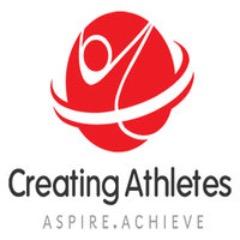

Kirk along with Sarah Hylton and Arran Peck from the LTA put together a great morning which included an on court Tennis practical session, then we had a presentation from Damien Bowyer of Norwich City FC and finally a Skype Q&A with Allistair McCaw. I’ll save the Allistair McCaw Q&A for next week’s Blog!
Below is a summary of some of the key take home messages.
Movement session with Sarah Hylton and Arran Peck:
This session was designed to get the S&C coaches to think about on court exercises we could use to help augment a tennis skill by targeting improvement in some of the physical qualities associated with the sports skill.
What’s important now- WIN?
For some S&C coaches this type of on court session may be outside of their comfort zone- especially if they don’t understand the movement demands of the game of Tennis. I think that it is important to respect that as S&C coaches we will make some long term improvements in KINETICS (Think: More force) by doing all the great work we do in the gym with squats, deadlifts and lunges etc. But I also think there are some ‘quick wins’ that we can make NOW if we can appreciate how to better express a movement by coaching the KINEMATICS (Think: Correct positioning of the joints). So it is always useful to think about the ‘now’ too.
Scenario 1: Lateral movement out wide: ability to recover quickly
S&C Intervention:
We broke down Agility- which is being put under the microscope here into it’s subcomponents. This is not an exhaustive list. These are just examples:
- Strength (isometric, concentric, eccentric)
- Power (explosive, reactive)
- Dynamic Stabilisation (proprioception)
- Coordination
As a group we came up with a few drills to develop the physical component- working at the high end of movement demand and regressing back to the appropriate level of challenge. It was felt recovery could be enhanced if the athlete could push back with outside leg more explosively.
Example:
Starting with the highest challenge first
- Assisted band work- where the athlete is being pulled into the position which challenges the deceleration component and they have to push back against resistance.
- Lateral ice skaters- back and forth- with or without a vertical single leg hop included
- Lateral ice skater- with a ‘freeze’
Controversial topic: Flexibility in Tennis
We also discussed Flexibility related to wide movement. This is the moment where I am going to raise a topic for discussion- do current and future stars of the game need as much flexibility as Djokovic- current world number 1 in Tennis to be as great as him? I.e. should younger players (and current pros) be looking at him and saying that I need to be that flexible?
Here is my thought on the subject- a degree of flexibility is required for all sports- some sports need more than the average amount and other sports may even benefit from a degree of stiffness around certain joints.
As we will see in the Injury Prevention presentation which I discuss below, it is definitely worth monitoring the length of muscles around certain joints- especially during Peak Height Velocity.
But ask yourself this, when Federer was dominating the sport of Tennis at his peak were we all looking at him and thinking that players needed to be as flexible as him? No we were talking about his unbelievable grace and poise of movement. Is there in fact a tactical reason why Djokovic allows himself to get into defensive positions where he has to hit on the reach compared to Federer who you may argue finish points sooner before he is ever on the run.
Scenario 2: Lateral movement out wide: ability to load leg

How could we encourage the athlete to load his thigh more? And drive up into the shot.
[My personal opinion is that we can go down the wrong path here if we start putting too much emphasis on loading excessively- particularly on fast hard courts as it can disturb the natural sequence of the kinetic chain. If you are almost ‘waiting too long’ you can lose the energy you built up in the legs and can hit the ball too late. But as a principle of loading the legs to hit a shot yes- I would like to see our younger players getting into the sort of positions you see Mr Federer in above]
Example:
Starting with the highest challenge first
- Medicine ball throw (dynamic)- where the athlete moves with the ball into the position first and then throws the ball back.
- Medicine ball throw (static)- where the athlete is stationary whilst they throw it to the coach
- Weighted vest / resistance band- where the athlete has to work harder with the legs to overcome the vertical resistance (vest) or lateral resistance from the band
Scenario 3: First Serve- ability to load leg
I hold the opinion that we can find ourselves going down the wrong path if we try and be too specific in overloading the serve action. I have read Mark Kovac’s journal article: 8 Stage Model for Evaluating the Tennis Serve: Implications for Performance Enhancement and Injury Prevention. For those of you interested he has also followed up with some great seminars which are available online where he describes:
a) the importance of getting the hips back to properly load the legs- and the related single leg squats and lateral band walk exercises we can do to develop the lower extremities
b) the serve acceleration phase- in terms of a shot putt type action rather than a typical baseball type throw and the associated shoulder exercises we can do to condition the upper extremities.
There are no doubt benefits to strengthening the body to help with the serve. The group came up with some jump progressions which emphasised a hip back start position.
Example:
Starting with the lowest challenge first
- Squat jump (no counter movement) to jump to a knee height box
- Counter movement jump to box
- Side on counter movement jump to box with quarter turn in air- so you land in same position as exercise 1 and 2
Injury Prevention Presentation with Damien Bowyer, NCFC Academy
Here are a few key take home messages:
- Football Clubs can expect 88% player availability across season with a typical pro experiencing two injuries per season
- Youth football is associated with higher occurrence of non-contact injuries which coincides with rapid changes in stature and mass at the time when there is also increased exposure to training and competition.
- Injury Prevention Strategies must be multi-faceted
- S&C sessions are informed by Movement Competency Screening which is conducted 3 times per year and follows a progressive strategy as players progress through their athletic development
- Pre Peak Height velocity (Movement competency based) strength programme versus Post Peak Height Velocity (phased implementation of strength/power/plyometric programme). Damien acknowledged that some athletes move better under load and so may be introduced to load sooner. This represents a departure from their original philosophy of not loading until after PHV.
Question mark for me over whether 20-30 minutes three times per week is enough but I acknowledge that this is built along side units of activation and warm-ups.
- Use of Mathematical algorithms with good validity/reliability to predict time and length of PHV.
- More regular monitoring of flexibility during Peak Height Velocity (calf, hamstring, hip flexor/quad)
- Modification of loading during periods of rapid growth
Summary:
Hope that has got you thinking about your own programmes. Let me know your thoughts.
Services
Your Account
Shop Now
-
 Tennis Fitness Camps
£10.00 – £15.00
Tennis Fitness Camps
£10.00 – £15.00
-
 Tennis Conditioning Blueprint - Serve EBook
£3.99
Tennis Conditioning Blueprint - Serve EBook
£3.99
-
 Tennis Conditioning Blueprint - Groundstrokes EBook
£3.99
Tennis Conditioning Blueprint - Groundstrokes EBook
£3.99

